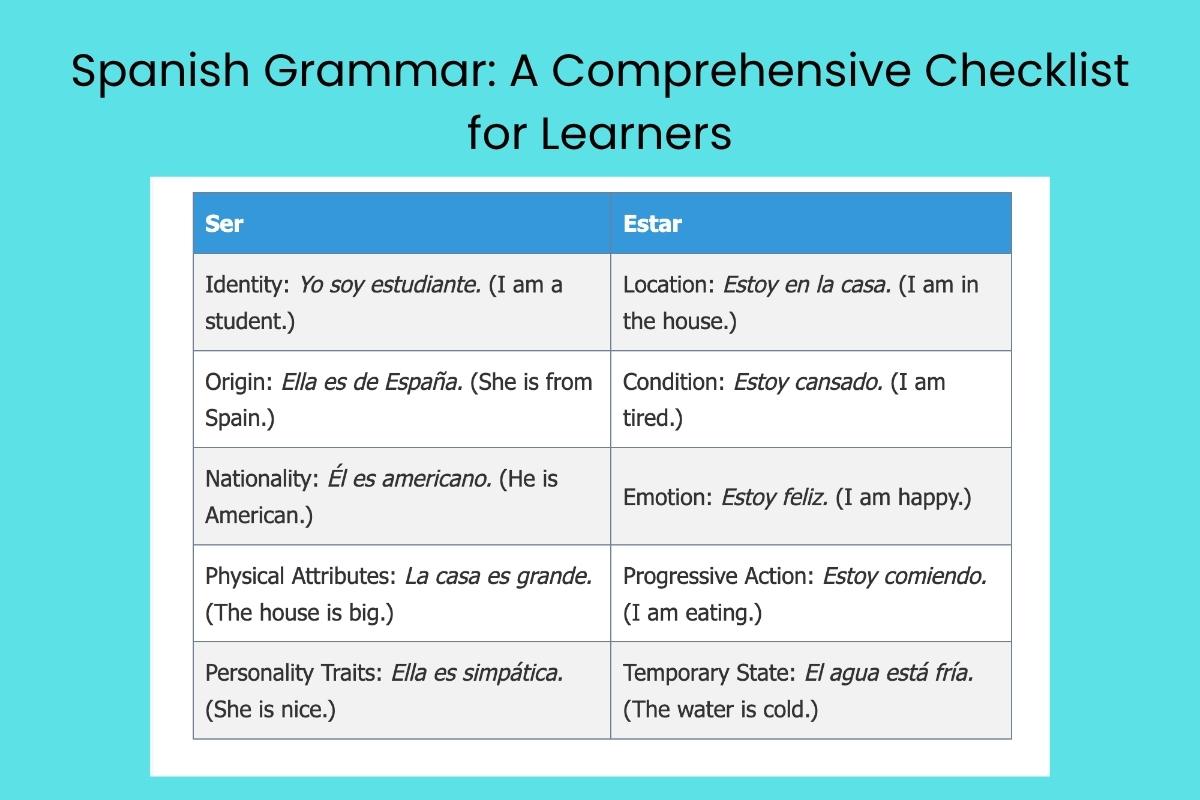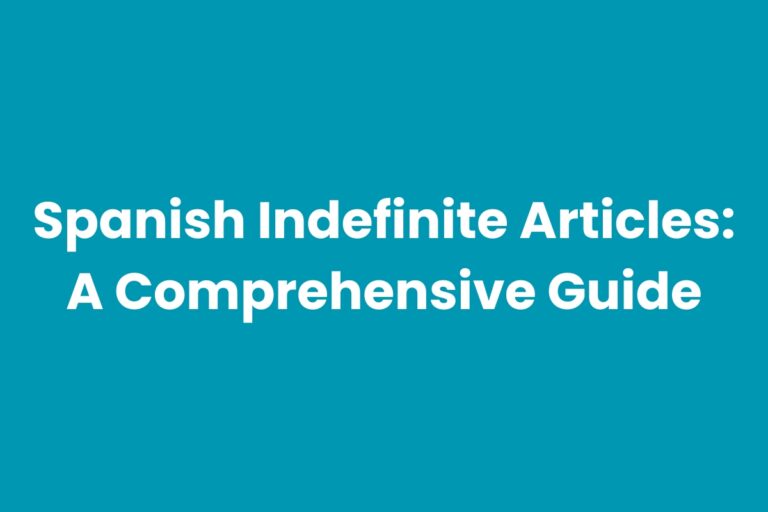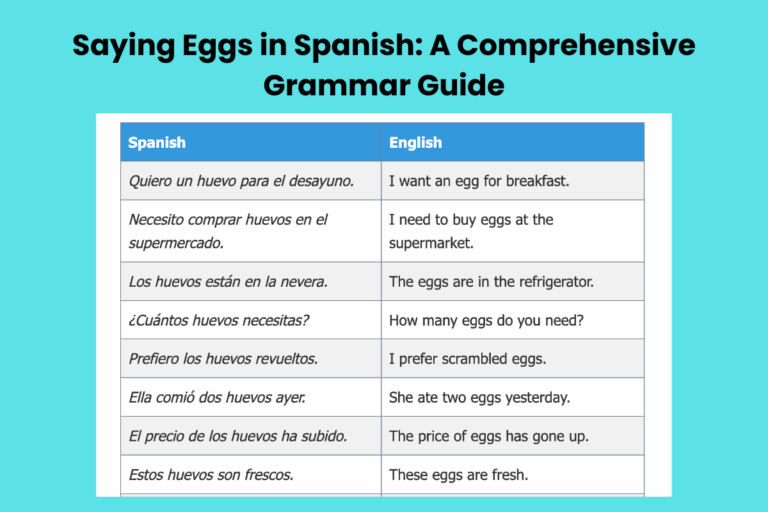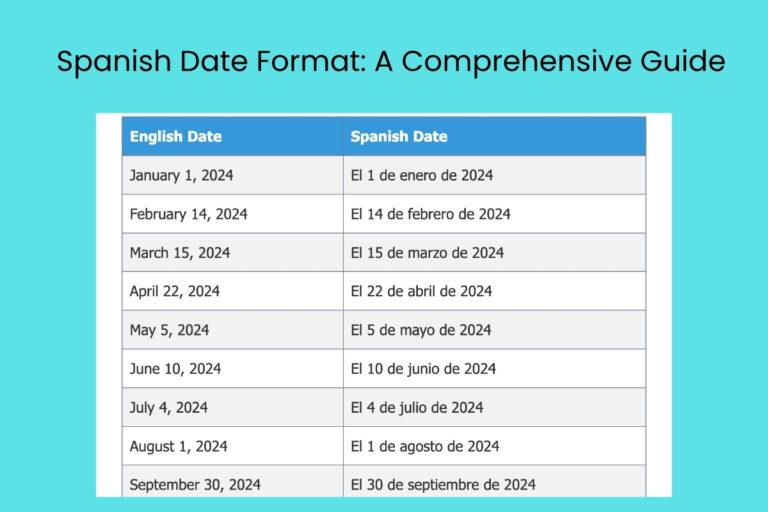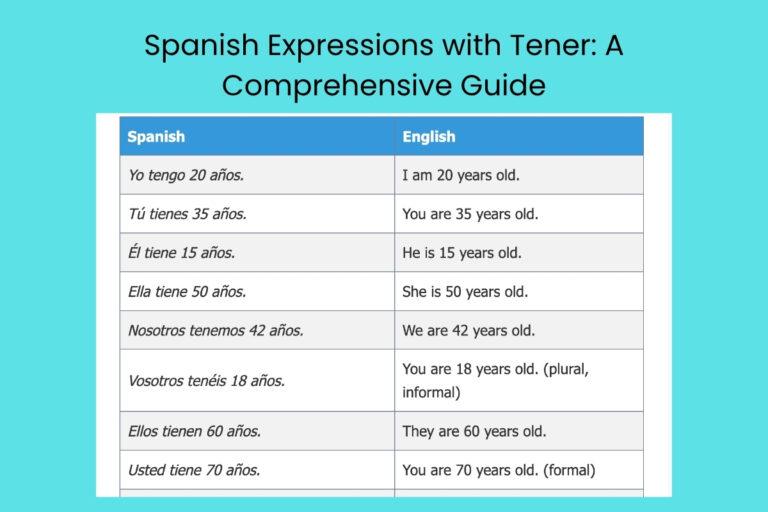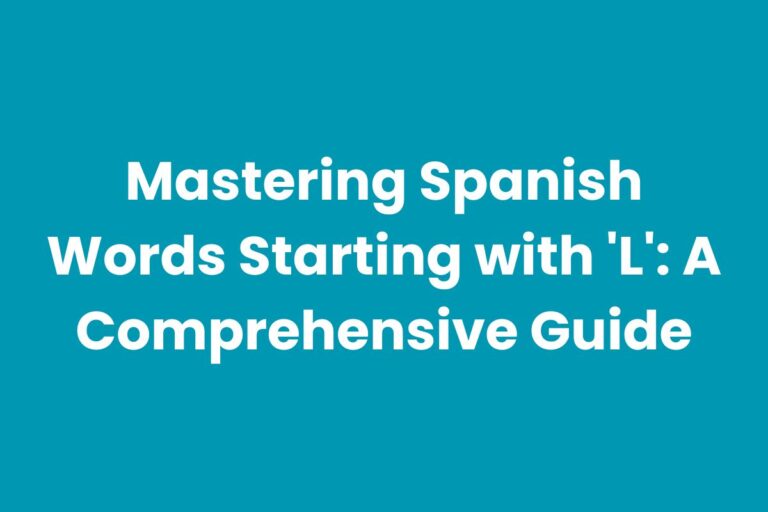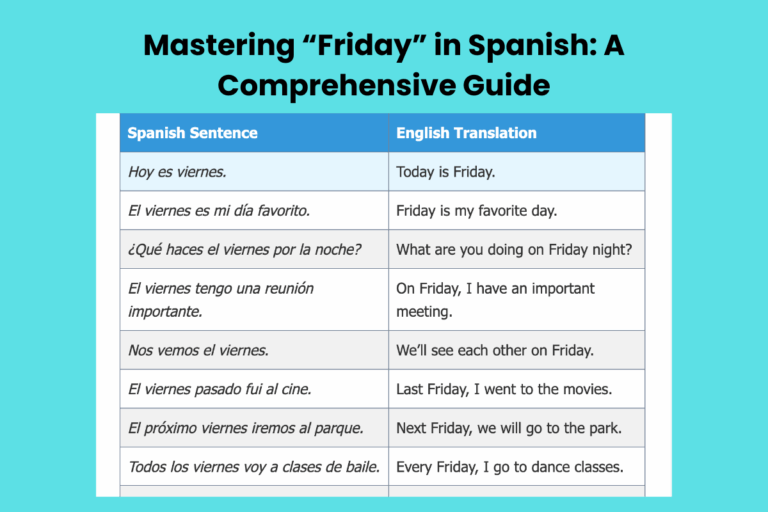Spanish Grammar: A Comprehensive Checklist for Learners
Mastering Spanish grammar is essential for effective communication and a deeper understanding of the language and culture. This article provides a comprehensive checklist of key grammar points, designed to guide learners from beginner to advanced levels.
By understanding and applying these concepts, you’ll be well-equipped to express yourself accurately and confidently in Spanish. Whether you’re just starting your Spanish journey or looking to refine your skills, this guide will serve as a valuable resource for achieving fluency.
Table of Contents
- Introduction
- Nouns and Articles
- Adjectives
- Verbs
- Verb Tenses
- Pronouns
- Adverbs
- Prepositions
- Sentence Structure
- Ser vs. Estar
- Por vs. Para
- Common Mistakes
- Practice Exercises
- Advanced Topics
- FAQ
- Conclusion
Nouns and Articles
Nouns in Spanish, like in many other languages, are words that represent people, places, things, or ideas. Articles are words used to define whether a noun is specific or unspecific.
Mastering nouns and articles is fundamental to constructing grammatically correct sentences.
Noun Gender
Spanish nouns have gender: either masculine or feminine. This is often, but not always, related to the biological sex of the referent. Generally, nouns ending in -o are masculine, and nouns ending in -a are feminine. However, there are many exceptions.
For example, el libro (the book) is masculine, while la mesa (the table) is feminine. Some nouns have the same form but different genders, changing the meaning. For instance, el capital (capital – money) is masculine, while la capital (capital – city) is feminine.
Noun Number
Spanish nouns also have number: singular or plural. To make most nouns plural, add -s if the noun ends in a vowel, and -es if it ends in a consonant. If a noun ends in -z, change the -z to -c and add -es.
For example, el libro (the book) becomes los libros (the books), and la pared (the wall) becomes las paredes (the walls). The word lápiz (pencil) becomes lápices (pencils) in the plural form.
Definite Articles
Definite articles (el, la, los, las) are used to refer to specific nouns, similar to “the” in English. The article must agree in gender and number with the noun it modifies. El is masculine singular, la is feminine singular, los is masculine plural, and las is feminine plural.
For example, el hombre (the man), la mujer (the woman), los hombres (the men), and las mujeres (the women). Note how the article changes based on the gender and number of the noun.
Indefinite Articles
Indefinite articles (un, una, unos, unas) are used to refer to non-specific nouns, similar to “a” or “an” in English. Like definite articles, they must agree in gender and number with the noun they modify. Un is masculine singular, una is feminine singular, unos is masculine plural, and unas is feminine plural.
For example, un libro (a book), una mesa (a table), unos libros (some books), and unas mesas (some tables). The indefinite article indicates that we are not referring to a specific book or table, but rather any book or table.
Adjectives
Adjectives are words that describe nouns. In Spanish, adjectives must agree in gender and number with the nouns they modify.
This agreement is a crucial aspect of Spanish grammar.
Adjective Agreement
Adjectives in Spanish must agree in gender (masculine or feminine) and number (singular or plural) with the noun they modify. This means that the ending of the adjective will change to match the noun.
For example:
* El libro rojo (The red book) – masculine singular
* La casa roja (The red house) – feminine singular
* Los libros rojos (The red books) – masculine plural
* Las casas rojas (The red houses) – feminine plural
Adjective Position
In Spanish, adjectives usually follow the noun they modify. However, some adjectives, especially those indicating quantity or subjective qualities, often precede the noun.
The position can sometimes change the meaning of the adjective.
For example:
* El coche nuevo (The new car) – a car that is new.
* El nuevo coche (The new car) – a different car, perhaps a replacement.
* Una mujer pobre (A poor woman) – a woman who is poor (lacking money).
* Una pobre mujer (A poor woman) – a woman who is unfortunate.
Comparative and Superlative Adjectives
Comparative adjectives are used to compare two things, while superlative adjectives are used to describe something as being the most or least of a particular quality. Spanish uses specific structures to form these adjectives.
To form a comparative adjective, use más (more) or menos (less) + adjective + que (than). To form a superlative adjective, use el/la/los/las + más/menos + adjective + de.
Examples:
- Este libro es más interesante que ese. (This book is more interesting than that one.)
- Ella es la más alta de la clase. (She is the tallest in the class.)
Verbs
Verbs are words that express actions, occurrences, or states of being. Understanding verb conjugation is essential for forming grammatically correct sentences in Spanish.
Verb Conjugation
Verb conjugation is the process of changing the form of a verb to agree with the subject pronoun. Spanish verbs are typically grouped into three conjugations based on their infinitive endings: -ar, -er, and -ir.
Each conjugation has its own set of endings for each tense. Learning these endings is crucial for speaking and writing accurately in Spanish. The subject pronouns are: yo (I), tú (you, informal), él/ella/usted (he/she/you, formal), nosotros/nosotras (we), vosotros/vosotras (you, informal plural, used in Spain), and ellos/ellas/ustedes (they/you, formal plural).
Regular Verbs
Regular verbs follow predictable conjugation patterns. To conjugate a regular verb, remove the infinitive ending (-ar, -er, or -ir) and add the appropriate ending for the tense and subject pronoun.
For the present tense, the endings are as follows:
| Pronoun | -ar Verbs | -er Verbs | -ir Verbs |
|---|---|---|---|
| Yo | -o | -o | -o |
| Tú | -as | -es | -es |
| Él/Ella/Usted | -a | -e | -e |
| Nosotros/Nosotras | -amos | -emos | -imos |
| Vosotros/Vosotras | -áis | -éis | -ís |
| Ellos/Ellas/Ustedes | -an | -en | -en |
For example, the regular verb hablar (to speak) is conjugated in the present tense as follows: yo hablo, tú hablas, él/ella/usted habla, nosotros/nosotras hablamos, vosotros/vosotras habláis, ellos/ellas/ustedes hablan.
Irregular Verbs
Irregular verbs do not follow predictable conjugation patterns. They have unique forms that must be memorized. Many common verbs, such as ser (to be), estar (to be), tener (to have), and ir (to go), are irregular.
For example, the verb ser (to be) is conjugated in the present tense as follows: yo soy, tú eres, él/ella/usted es, nosotros/nosotras somos, vosotros/vosotras sois, ellos/ellas/ustedes son. Notice that these forms are completely different from the regular verb endings.
Reflexive Verbs
Reflexive verbs are used when the subject of the verb performs an action on themselves. They are identified by the reflexive pronoun se attached to the infinitive form (e.g., lavarse – to wash oneself).
When conjugating a reflexive verb, the reflexive pronoun must be placed before the conjugated verb and must agree with the subject pronoun.
The reflexive pronouns are: me (myself), te (yourself, informal), se (himself/herself/yourself, formal), nos (ourselves), os (yourselves, informal plural, used in Spain), and se (themselves/yourselves, formal plural).
For example, the verb lavarse (to wash oneself) is conjugated in the present tense as follows: yo me lavo, tú te lavas, él/ella/usted se lava, nosotros/nosotras nos lavamos, vosotros/vosotras os laváis, ellos/ellas/ustedes se lavan.
Verb Tenses
Spanish has a rich system of verb tenses that allow you to express actions in the past, present, and future. Understanding these tenses is crucial for conveying meaning accurately.
Present Tense
The present tense is used to describe actions happening now, habitual actions, or general truths. It is formed by conjugating the verb according to the subject pronoun and the verb’s conjugation type (-ar, -er, or -ir).
Examples:
- Yo hablo español. (I speak Spanish.)
- Ella come fruta todos los días. (She eats fruit every day.)
- El sol brilla. (The sun shines.)
Preterite Tense
The preterite tense is used to describe completed actions in the past that had a definite beginning and end. It is one of the two main past tenses in Spanish.
The preterite endings are as follows:
| Pronoun | -ar Verbs | -er/-ir Verbs |
|---|---|---|
| Yo | -é | -í |
| Tú | -aste | -iste |
| Él/Ella/Usted | -ó | -ió |
| Nosotros/Nosotras | -amos | -imos |
| Vosotros/Vosotras | -asteis | -isteis |
| Ellos/Ellas/Ustedes | -aron | -ieron |
For example, the verb hablar (to speak) is conjugated in the preterite tense as follows: yo hablé, tú hablaste, él/ella/usted habló, nosotros/nosotras hablamos, vosotros/vosotras hablasteis, ellos/ellas/ustedes hablaron.
Examples:
- Yo comí pizza ayer. (I ate pizza yesterday.)
- Ella vivió en España por dos años. (She lived in Spain for two years.)
- Nosotros fuimos al cine el sábado pasado. (We went to the cinema last Saturday.)
Imperfect Tense
The imperfect tense is used to describe ongoing or habitual actions in the past, as well as to provide background information or set the scene. It is the other main past tense in Spanish.
The imperfect endings are as follows:
| Pronoun | -ar Verbs | -er/-ir Verbs |
|---|---|---|
| Yo | -aba | -ía |
| Tú | -abas | -ías |
| Él/Ella/Usted | -aba | -ía |
| Nosotros/Nosotras | -ábamos | -íamos |
| Vosotros/Vosotras | -abais | -íais |
| Ellos/Ellas/Ustedes | -aban | -ían |
For example, the verb hablar (to speak) is conjugated in the imperfect tense as follows: yo hablaba, tú hablabas, él/ella/usted hablaba, nosotros/nosotras hablábamos, vosotros/vosotras hablabais, ellos/ellas/ustedes hablaban.
Examples:
- Yo comía pizza todos los viernes. (I used to eat pizza every Friday.)
- Ella vivía en España cuando era niña. (She lived in Spain when she was a child.)
- Nosotros íbamos al cine con frecuencia. (We used to go to the cinema frequently.)
Future Tense
The future tense is used to describe actions that will happen in the future. In Spanish, the future tense can be formed in two ways: using the simple future or using the ir a + infinitive construction.
The simple future endings are added to the infinitive form of the verb:
| Pronoun | Future Endings |
|---|---|
| Yo | -é |
| Tú | -ás |
| Él/Ella/Usted | -á |
| Nosotros/Nosotras | -emos |
| Vosotros/Vosotras | -éis |
| Ellos/Ellas/Ustedes | -án |
For example, the verb hablar (to speak) is conjugated in the simple future tense as follows: yo hablaré, tú hablarás, él/ella/usted hablará, nosotros/nosotras hablaremos, vosotros/vosotras hablaréis, ellos/ellas/ustedes hablarán.
The ir a + infinitive construction is more common and is similar to “going to” in English. For example, Voy a comer (I am going to eat).
Examples:
- Yo comeré pizza mañana. (I will eat pizza tomorrow.)
- Ella va a vivir en España el próximo año. (She is going to live in Spain next year.)
- Nosotros iremos al cine el fin de semana. (We will go to the cinema on the weekend.)
Conditional Tense
The conditional tense is used to express what would happen under certain conditions or to make polite requests. The conditional endings are added to the infinitive form of the verb, similar to the future tense.
| Pronoun | Conditional Endings |
|---|---|
| Yo | -ía |
| Tú | -ías |
| Él/Ella/Usted | -ía |
| Nosotros/Nosotras | -íamos |
| Vosotros/Vosotras | -íais |
| Ellos/Ellas/Ustedes | -ían |
For example, the verb hablar (to speak) is conjugated in the conditional tense as follows: yo hablaría, tú hablarías, él/ella/usted hablaría, nosotros/nosotras hablaríamos, vosotros/vosotras hablaríais, ellos/ellas/ustedes hablarían.
Examples:
- Yo comería pizza si tuviera hambre. (I would eat pizza if I were hungry.)
- Ella viviría en España si pudiera. (She would live in Spain if she could.)
- Nosotros iríamos al cine si tuviéramos tiempo. (We would go to the cinema if we had time.)
Subjunctive Mood
The subjunctive mood is used to express doubt, uncertainty, wishes, emotions, and opinions. It is often used in subordinate clauses that are introduced by conjunctions such as que (that), si (if), para que (so that), and a menos que (unless).
The subjunctive endings are different from the indicative endings and vary depending on the tense. It is important to learn the subjunctive conjugations to express these types of sentiments accurately.
Examples:
- Es importante que estudies. (It’s important that you study.)
- Dudo que ella venga. (I doubt that she will come.)
- Quiero que seas feliz. (I want you to be happy.)
Pronouns
Pronouns are words that replace nouns. Spanish has several types of pronouns, each with its own function.
Subject Pronouns
Subject pronouns replace the subject of a sentence. They are: yo (I), tú (you, informal), él/ella/usted (he/she/you, formal), nosotros/nosotras (we), vosotros/vosotras (you, informal plural, used in Spain), and ellos/ellas/ustedes (they/you, formal plural).
Examples:
- Yo hablo español. (I speak Spanish.)
- Ella come fruta. (She eats fruit.)
- Nosotros vamos al cine. (We go to the cinema.)
Object Pronouns
Object pronouns replace the object of a verb. There are two types: direct object pronouns and indirect object pronouns.
Direct object pronouns (me, te, lo/la, nos, os, los/las) replace the direct object of a verb, which is the person or thing that receives the action of the verb.
Indirect object pronouns (me, te, le, nos, os, les) replace the indirect object of a verb, which is the person or thing that receives the benefit or harm of the action of the verb.
Examples:
- Yo te veo. (I see you.) – direct object pronoun
- Yo le doy un libro a Juan. (I give a book to Juan.) – indirect object pronoun
- Yo le doy un libro. (I give him a book.) – indirect object pronoun
Reflexive Pronouns
Reflexive pronouns (me, te, se, nos, os, se) are used with reflexive verbs, where the subject of the verb performs an action on themselves.
Examples:
- Yo me lavo. (I wash myself.)
- Ella se viste. (She gets dressed.)
- Nosotros nos despertamos temprano. (We wake up early.)
Possessive Pronouns
Possessive pronouns (mío/mía/míos/mías, tuyo/tuya/tuyos/tuyas, suyo/suya/suyos/suyas, nuestro/nuestra/nuestros/nuestras, vuestro/vuestra/vuestros/vuestras, suyo/suya/suyos/suyas) indicate ownership. They must agree in gender and number with the noun they replace.
Examples:
- Este libro es mío. (This book is mine.)
- La casa es suya. (The house is hers/his/theirs/yours, formal.)
- Los coches son nuestros. (The cars are ours.)
Demonstrative Pronouns
Demonstrative pronouns (éste/ésta/ésto, ése/ésa/éso, aquél/aquélla/aquéllo) point out specific nouns. They must agree in gender and number with the noun they replace. They translate to “this one,” “that one,” and “that one over there,” respectively.
Examples:
- Éste es mi libro. (This one is my book.)
- Ésa es su casa. (That one is her house.)
- Aquél es mi coche. (That one over there is my car.)
Adverbs
Adverbs are words that modify verbs, adjectives, or other adverbs. They provide information about how, where, when, or to what extent an action is performed.
Adverbs of Manner
Adverbs of manner describe how an action is performed. Many adverbs of manner are formed by adding -mente to the feminine singular form of the adjective.
Examples:
- rápidamente (quickly)
- lentamente (slowly)
- fácilmente (easily)
Examples in sentences:
- Ella habla rápidamente. (She speaks quickly.)
- Él camina lentamente. (He walks slowly.)
- Podemos resolver este problema fácilmente. (We can solve this problem easily.)
Adverbs of Place
Adverbs of place describe where an action is performed.
Examples:
- aquí (here)
- allí (there)
- cerca (near)
- lejos (far)
Examples in sentences:
- Estoy aquí. (I am here.)
- Ella vive allí. (She lives there.)
- El banco está cerca. (The bank is near.)
- La escuela está lejos. (The school is far.)
Adverbs of Time
Adverbs of time describe when an action is performed.
Examples:
- hoy (today)
- ayer (yesterday)
- mañana (tomorrow)
- siempre (always)
- nunca (never)
Examples in sentences:
- Voy al cine hoy. (I am going to the cinema today.)
- Ella llegó ayer. (She arrived yesterday.)
- Volveré mañana. (I will return tomorrow.)
- Siempre estudio. (I always study.)
- Nunca fumo. (I never smoke.)
Adverbs of Degree
Adverbs of degree describe the intensity of an action or quality.
Examples:
- muy (very)
- poco (little)
- mucho (much)
- bastante (enough/quite)
Examples in sentences:
- Estoy muy cansado. (I am very tired.)
- Ella come poco. (She eats little.)
- Él trabaja mucho. (He works a lot.)
- Tengo bastante dinero. (I have enough money.)
Prepositions
Prepositions are words that connect nouns or pronouns to other words in a sentence, indicating relationships such as location, direction, time, or manner. Some common Spanish prepositions include a (to), de (of/from), en (in/on), por (for/by), and para (for/to).
Examples:
- Voy a la escuela. (I am going to school.)
- El libro es de Juan. (The book is Juan’s.)
- Estoy en la casa. (I am in the house.)
- Lo hago por ti. (I do it for you.)
- Esto es para ti. (This is for you.)
Sentence Structure
Understanding the basic sentence structure in Spanish is crucial for forming clear and grammatically correct sentences.
Subject-Verb Agreement
In Spanish, the verb must agree in number and person with the subject. This means that the verb ending must change to match the subject pronoun or noun.
Examples:
- Yo hablo español. (I speak Spanish.)
- Ella come fruta. (She eats fruit.)
- Nosotros vamos al cine. (We go to the cinema.)
- Los estudiantes estudian mucho. (The students study a lot.)
Word Order
The typical word order in Spanish is Subject-Verb-Object (SVO), similar to English. However, Spanish is more flexible than English, and the word order can be changed for emphasis or stylistic reasons.
Examples:
- Yo como pizza. (I eat pizza.) – SVO
- Pizza como yo. (Pizza I eat.) – OVS (emphasis on the pizza)
- A Juan le gusta el fútbol. (Juan likes soccer.) – atypical word order with indirect object pronoun
Ser vs. Estar
Both ser and estar mean “to be” in Spanish, but they are used in different contexts. Understanding the difference between them is crucial for expressing the correct meaning.
Ser is used to describe permanent or inherent characteristics, such as identity, origin, nationality, physical attributes, and personality traits.
Estar is used to describe temporary states, conditions, emotions, locations, and progressive actions.
| Ser | Estar |
|---|---|
| Identity: Yo soy estudiante. (I am a student.) | Location: Estoy en la casa. (I am in the house.) |
| Origin: Ella es de España. (She is from Spain.) | Condition: Estoy cansado. (I am tired.) |
| Nationality: Él es americano. (He is American.) | Emotion: Estoy feliz. (I am happy.) |
| Physical Attributes: La casa es grande. (The house is big.) | Progressive Action: Estoy comiendo. (I am eating.) |
| Personality Traits: Ella es simpática. (She is nice.) | Temporary State: El agua está fría. (The water is cold.) |
Por vs
and Para
Both por and para can mean “for” in Spanish, but they are used in different contexts to express different relationships.
Por is used to indicate:
- Cause or reason: Lo hago por ti. (I do it for you/because of you.)
- Duration of time: Estudié por dos horas. (I studied for two hours.)
- Movement through a place: Caminé por el parque. (I walked through the park.)
- Exchange or price: Pagué diez dólares por el libro. (I paid ten dollars for the book.)
- Means of transportation or communication: Viajo por avión. (I travel by plane.)
Para is used to indicate:
- Purpose or goal: Estudio para ser médico. (I study to be a doctor.)
- Destination: Voy para España. (I am going to Spain.)
- Recipient: Este regalo es para ti. (This gift is for you.)
- Deadline: Necesito el informe para mañana. (I need the report by tomorrow.)
- Comparison or opinion: Para ser tan joven, es muy inteligente. (For being so young, he is very intelligent.)
Common Mistakes
Spanish learners often make certain common mistakes. Being aware of these can help you avoid them and improve your accuracy.
- Incorrect verb conjugation: Make sure the verb agrees with the subject in number and person.
- Misusing ser and estar: Remember that ser is for permanent characteristics, while estar is for temporary states.
- Confusing por and para: Understand the different uses of each preposition.
- Incorrect adjective agreement: Adjectives must agree in gender and number with the nouns they modify.
- Forgetting the personal a: Use the personal a before a direct object that is a person or pet. For example, Veo a Juan. (I see Juan.)
Practice Exercises
Practice is essential for mastering Spanish grammar. Here are some exercises to help you reinforce what you’ve learned.
Advanced Topics
Once you have a solid foundation in the basics, you can explore more advanced topics in Spanish grammar.
- Subjunctive in noun clauses: Learn when to use the subjunctive after expressions of doubt, uncertainty, or emotion.
- Conditional sentences: Master the different types of conditional sentences and their verb tenses.
- Passive voice: Understand how to form and use the passive voice in Spanish.
- Relative clauses: Learn how to use relative pronouns to connect clauses and provide additional information.
- Advanced prepositional usage: Explore the nuances of prepositions and their idiomatic uses.
FAQ
Conclusion
Mastering Spanish grammar is a journey that requires dedication and practice. By understanding and applying the key grammar points outlined in this article, you can improve your accuracy, fluency, and confidence in Spanish.
Remember to practice regularly, seek feedback, and continue exploring the rich and diverse world of the Spanish language.

